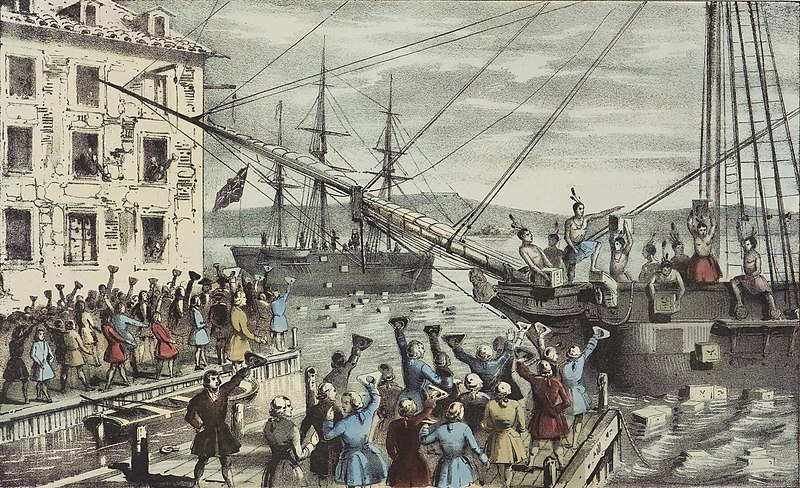This Week in Maritime History: Boston Tea Party, Mayflower Docks at Plymouth Harbor

December 16, 1773: The Boston Tea Party
In colonial America, a group of Massachusetts colonists decided to take matters of British imperial injustice into their own hands on December 16th of 1773 when they disguised themselves as Mohawk Indians and boarded three British tea ships, and dumped 342 chests of tea into the Boston Harbor, creating one of the most famous pre-revolution rebellion acts in American history.
The incident, conducted under veil of darkness and disguise, was in protest of the Parliament’s Tea Act of 1773, which was designed by the British government to save the waning East India Company by greatly lowering their tea tax, and thereby established a monopoly among tea trade in America. The tax cuts for East India Co. allowed the tea conglomerate to even undercut tea that was smuggled into America by Dutch traders. The taxation created a stir among the colonists, who viewed the legislation as an example of the growing tyranny of British-imposed taxation.

PHOTO: "The Destruction of Tea at Boston Harbor", lithograph depicting the 1773 Boston Tea Party.
Three tea ships arrived in the Boston Harbor after the tax cut was enacted, and the colonists demanded that the ships were returned to England. When Massachusetts governor refused, leader of the Patriot movement, Samuel Adams, organized for the resistance to be set into motion, along with 60 members of his underground rebel group known as the Sons of Liberty. On the evening of December 16th, the men dumped the 342 chests of tea valued at $18,000 in 1773.
British Parliament was outraged by the resistance which was dubbed the ‘Boston Tea Party’, and enacted further legislation that hindered American trade, closing all of Boston to merchant shipping, and installing British military presence in the colony. These actions lead directly to the colonists’ first Continental Congress, where the foundation for the American Revolution was built.
December 18, 1620: Mayflower Docks at Plymouth Harbor
The saga of the Mayflower began in 1606. Reformed Puritans residing in England founded their own church, in an act of boldness and opposition to the state-sanctioned Church of England. All involved were subsequently accused of treason and forced out of their home country to the less stringent government of the Netherlands. The ex-pats struggled to make the Netherlands their home, but after 12 years decided to seek financial backing to set up a colony in America where they believed they could make a better living.
In September of 1620, 102 passengers, who were coined “Pilgrims” by passenger and soon-to-be first American governor, William Bradford, embarked on the crowded Mayflower ship for an arduous transatlantic journey to a new life, and a new world.

PHOTO: "Mayflower in Plymouth Harbor," by William Halsall, 1882 at Pilgrim Hall Museum, Plymouth, Massachusetts, USA
The Mayflower reached what is now Cape Cod on November 11th, 1620, when the Mayflower Compact was signed and male passengers went to gather fire wood, and scout the best place for the Pilgrims to build their new settlement. Over the next month, scouting groups were dispatched until they finally found a harbor on the western side of Cape Cod Bay that struck their fancy.
On December 18th of 1620, the immigrants docked at modern-day Plymouth, Massachusetts, and began their settlement into the new world of America. A brutal winter hit the new colonists that year, and 50 of the original 102 Mayflower passengers died within months.
The Mayflower and its crew left the new colony to return to England on April 5th, 1621, and over the next several decades, more and more settlers made the journey to Plymouth, growing the colony into a successful shipbuilding and fishing center, and solidified its place in history as the first Pilgrim settlement in America.
Related Articles:
